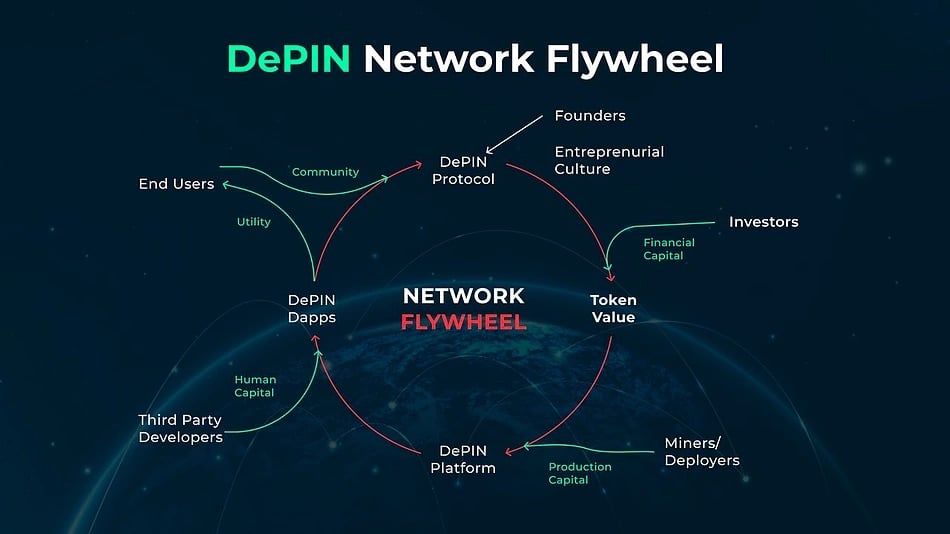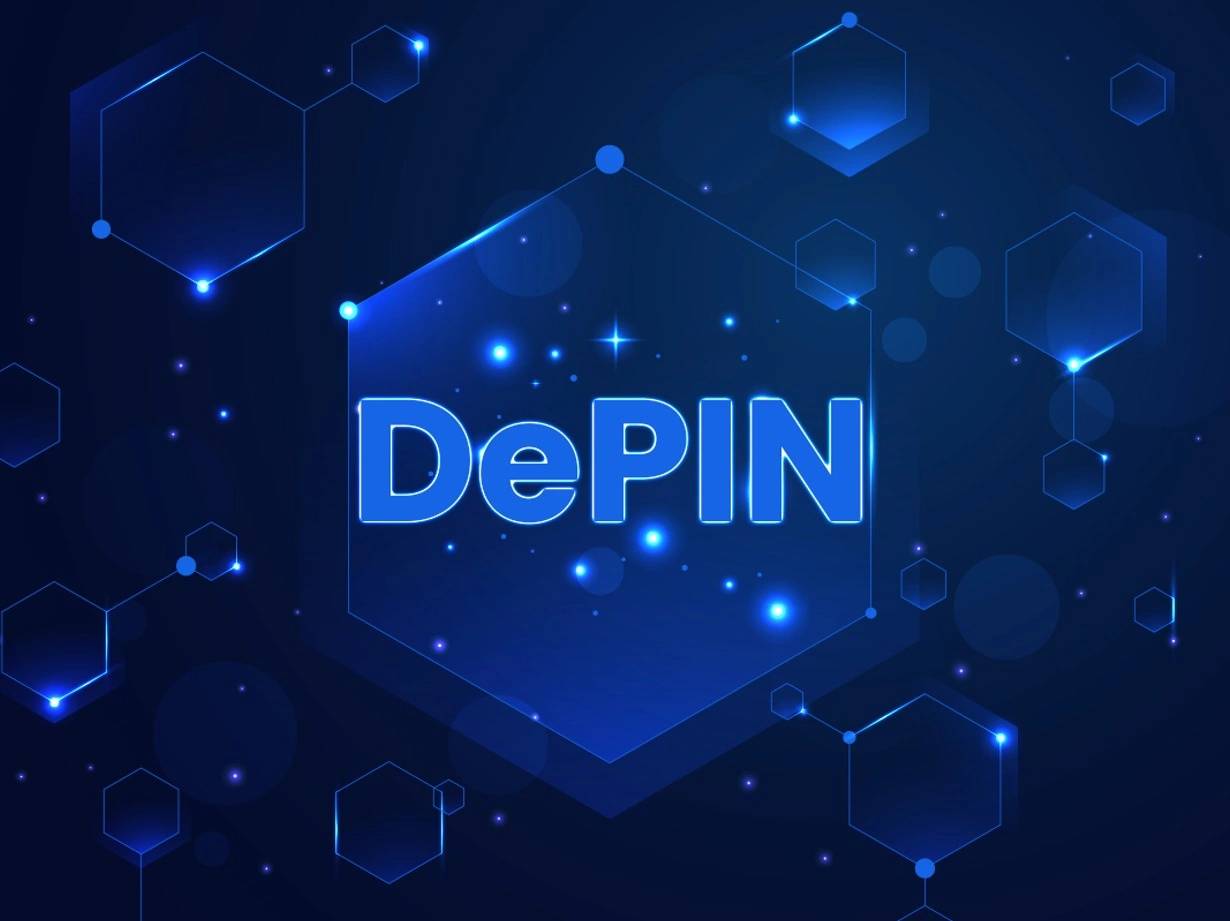위키 구독하기
Share wiki
Bookmark
DePIN
에이전트 토큰화 플랫폼 (ATP):에이전트 개발 키트(ADK)로 자율 에이전트 구축
DePIN
DePIN(Decentralized Physical Infrastructure Network, 디핀)은 물리적 세계를 블록체인 기술에 연결하는 블록체인 네트워크로, 물리적 인프라의 제어 및 소유권을 분산합니다.[1]
개요
DePIN(디핀)은 블록체인 프로토콜의 네트워크로, 분산되고 개방적인 방식으로 물리적 하드웨어 인프라의 개발, 유지 관리 및 운영을 가능하게 합니다. 이러한 네트워크는 불변성, 투명성, 보안과 같은 블록체인 기술의 강점을 활용하여 개방형 시장을 통해 하드웨어 수요를 충족하는 피어투피어(P2P) 네트워크를 구축합니다.[2]
기존에는 데이터 네트워크, 교통 또는 전력망과 같은 물리적 인프라가 중앙화된 기관에 의해 소유 및 관리되었습니다. DePIN 프로젝트는 개인이 자신의 물리적 자원을 기여하고 네트워크에 대한 공유 제어권을 소유할 수 있는 피어투피어(P2P) 네트워크를 만들어 이를 대체하려고 합니다.[6]
DePIN은 암호화된 인센티브를 사용하여 중요한 인프라의 구축과 기능을 효율적으로 조정함으로써 물리적 인프라 시스템의 관리 및 운영 방식을 혁신합니다. 바이낸스 Research에서 정의한 바와 같이:
"DePIN은 더 투명하고 검증 가능한 네트워크를 구축하기 위해 개인이 자본이나 사용하지 않는 자원을 할당하도록 동기를 부여하는 블록체인 기술과 암호 경제학을 활용하는 인프라 관련 프로젝트를 의미합니다." [4]
DePIN의 중요성은 기존의 중앙화된 인프라 개발 방식에서 벗어났다는 데 있습니다. 이는 상당한 자본 요건과 물류적 복잡성으로 인해 대기업이 주도해 왔습니다. 이러한 중앙화 모델은 종종 독점에 가까운 결과를 초래하여 경쟁과 혁신을 저해했습니다. DePIN은 인프라의 소유권과 관리를 분산시키고 권한과 소유권을 사용자와 기여자에게 다시 분배함으로써 이러한 패러다임을 바꾸어 접근 및 참여를 민주화합니다.
DePIN은 어떻게 작동할까요?
DePIN은 물리적 시설과 블록체인을 연결합니다. 간단히 설명하면, 주요 역할을 하는 것은 제공자가 관리하는 물리적 시설, 시설을 블록체인에 연결하는 미들웨어, 그리고 송금을 위해 이 연결을 관리하는 공용 원장입니다.[3]
- 물리적 인프라: 물리적 시설은 센서나 인터넷 라우터부터 태양광 패널까지 어떤 것이든 될 수 있습니다. 이것은 개인 제공자가 관리합니다. 때때로 이러한 제공자는 DePIN 프로젝트에 참여하기 전에 이미 이러한 시설을 소유하고 있습니다. 가능한 한 많은 개인 제공자가 자신의 시설을 DePIN에 기여할 수 있습니다.
- 미들웨어: 미들웨어는 블록체인과 물리적 인프라 간의 연결의 대부분을 처리합니다. 외부 세계의 데이터를 수집하여 블록체인 애플리케이션에 전달하는 분산형 오라클 네트워크(DON)와 같습니다. 미들웨어는 유사한 역할을 수행합니다. 미들웨어는 각 개인 시설의 활동에 대한 데이터를 수집하여 DePI 네트워크에 전달합니다.
- 블록체인 시스템: 미들웨어에서 수집한 데이터는 제공자와 사용자를 위한 관리자 및 송금 시스템 역할을 하는 블록체인으로 전송됩니다. 미들웨어에서 제공한 데이터를 기반으로 블록체인은 제공자 간의 수요를 배분하고 이러한 활동에 따라 보상을 계산합니다. 보상은 암호화폐로 지급됩니다. 사용자 측면에서 블록체인은 가격 모델이 송금 시스템에 통합되어 사용자가 이용하는 각 서비스에 대해 즉시 요금이 청구되는 리소스 조달도 처리합니다.
DePIN의 운영 모델의 핵심에는 분산화와 토큰 경제라는 두 가지 기본적인 암호 개념이 있습니다. 다양한 암호화폐 부문의 기반을 형성하는 이러한 원칙은 DePIN에서 독특한 응용 프로그램을 찾아 물리적 인프라 관리에 대한 혁신적이고 변화된 접근 방식을 가능하게 합니다. 암호화폐와 블록체인 기술을 활용하여 DePIN은 물리적 인프라 관리 분야에서 전례 없는 권력과 소유권의 분산을 가능하게 합니다.[4]
DePIN 플라이휠 (Flywheel)
DePIN은 인센티브를 통해 자원 효율적인 물리적 인프라를 성장시키고자 합니다. 먼저, 제공자는 분산 네트워크에 자체 물리적 시설을 제공하도록 유인됩니다. 보상을 추구하는 많은 제공자들(일부는 유휴 시설을 보유하고 있을 수 있음)이 네트워크에 시설을 제공합니다. DePIN은 사용자 측에서 이러한 자원을 사용할 수 있도록 합니다. 네트워크는 사용자가 지불하는 수수료를 통해 수익을 창출합니다.
사용자는 기업 소유 시설에 비해 저렴한 서비스 요금에도 매력을 느낍니다. 네트워크가 성장함에 따라 네이티브 토큰의 가치가 상승하여 제공자에게는 더 많은 보상을, 투자자에게는 더 높은 매력을 제공하고, 더 많은 제공자를 유치하게 됩니다. 이러한 사이클이 계속되고 네트워크가 성장함에 따라 DePIN 플라이휠은 가속화됩니다.

DePIN의 4대 기둥
탈중앙화된 물리적 인프라(DePIN)의 4대 기둥은 다음과 같습니다.
- 클라우드 스토리지 네트워크/서버 네트워크: DePIN은 스토리지 및 서버 네트워크를 탈중앙화하여 탄력적이고 안전한 데이터 저장을 보장합니다. 일반적으로 중앙화된 서비스는 단일 지점 장애를 가지고 있습니다. 그러나 DePIN은 여러 스토리지 노드에 데이터를 분산하여 강력한 공용 스토리지 서비스 대안을 제공합니다. 여기에는 파일 스토리지, CDN, 관계형 데이터베이스 및 VPN 네트워크가 포함됩니다.[5] 탈중앙화된 스토리지 네트워크는 제공업체가 스토리지 공간을 제공하도록 유인하여 사용자에게 주문형 스토리지 공간을 제공합니다. Filecoin은 Protocol Labs에서 개발한 야심찬 탈중앙화된 스토리지 네트워크로, 전 세계 컴퓨터의 사용되지 않는 스토리지 용량을 활용하여 안전하고 효율적이며 확장 가능한 블록체인 기반 데이터 스토리지 시장을 구축하여 웹의 스토리지 인프라를 탈중앙화하고 Amazon Web Services, Google Cloud, Microsoft Azure와 같은 기존 클라우드 스토리지 제공업체에 대한 대안을 제시하고자 합니다.[4]
- 에너지 네트워크: DePIN의 탈중앙화된 에너지 네트워크는 에너지 거래 및 공유 방식을 변화시킵니다. 지역 사회 내에서 잉여 에너지를 직접 판매하거나 거래할 수 있도록 하고, 지역 사회 중심의 에너지 분배 방식을 촉진합니다. 이 네트워크는 분산된 에너지원을 집계하고 그리드의 탄력성과 효율성을 향상시킵니다.
- 센서 네트워크: DePIN의 탈중앙화된 센서 네트워크는 다양한 환경에서 정확하고 안전하며 투명한 데이터를 수집합니다. 이 시스템은 센서 데이터의 무결성과 접근성을 보장합니다. 실시간으로 데이터를 수집하는 센서가 장착된 네트워크 장치가 포함됩니다. 데이터 무결성과 매핑 기능을 향상시킵니다.
- 무선 네트워크: DePIN은 탈중앙화된 핫스팟 네트워크를 생성하여 5G 및 WiFi와 같은 무선 네트워크를 재정의합니다. 이러한 접근 방식은 인터넷 접근을 민주화합니다. 원격 또는 농촌 지역에서 기존 인터넷 서비스 제공업체(ISP)가 종종 남기는 연결 공백을 해결합니다. 또한 DePIN은 5G 및 LoRaWAN(사물 인터넷)과 같은 기술을 지원합니다.
DePIN의 기원과 발전
DePIN의 씨앗은 블록체인의 잠재력이 디지털 통화를 넘어 탐구되기 시작하면서 뿌려졌습니다. Power Ledger와 OpenBazaar와 같은 프로젝트는 블록체인이 에너지 분배와 전자상거래를 어떻게 탈중앙화할 수 있는지 보여줌으로써 기반을 마련했습니다. Power Ledger는 개인이 잉여 에너지를 P2P로 거래할 수 있도록 하여 더 효율적이고 지속 가능한 에너지 생태계를 조성했습니다.
한편, OpenBazaar는 온라인 상거래에서 중개자의 필요성을 없애고 구매자와 판매자 간의 직접적인 거래를 가능하게 했습니다. 이러한 개념이 탄력을 받으면서 다양한 분야에서 DePIN의 범위를 확장하는 새로운 이니셔티브가 등장했습니다. 예를 들어, Helium은 블록체인 기술을 활용하여 탈중앙화된 무선 네트워크를 구축하여 개인이 네트워크 커버리지 및 연결성을 제공하는 데 대한 보상을 받을 수 있도록 했습니다.
Render는 개발자와 기업에 확장 가능하고 비용 효율적인 인프라를 제공하는 탈중앙화된 클라우드 컴퓨팅 플랫폼을 도입했습니다. 일반적으로 중앙 집중식이며 단일 기업(예: Amazon Web Services, Microsoft Azure, Google Cloud)이 관리하는 기존 클라우드 컴퓨팅 서비스와 달리 Render의 플랫폼은 개별 제공업체 네트워크 전반에 걸쳐 컴퓨팅 리소스를 탈중앙화합니다.
Filecoin은 블록체인 기술을 활용하여 안전하고 분산된 데이터 저장 네트워크를 구축하여 참여자가 시장을 통해 사용하지 않는 저장 공간을 임대하는 데 대한 인센티브를 받는 탈중앙화된 저장소를 혁신했습니다.[8]
DePIN의 이점
연결된 스마트 기기와 탈중앙화 애플리케이션(dApps)의 급속한 성장을 고려할 때, DePIN은 업계의 주요 플레이어로 부상할 가능성이 있습니다. 다음은 기존 물리적 인프라에 비해 DePIN의 장점입니다.[5][7]
- 탈중앙화: DePIN은 중앙화된 모델에서 탈중앙화된 모델로의 중요한 전환을 의미합니다. 물리적 인프라의 설치 및 유지 관리를 위해 단일 기관이나 기업에 의존하는 것을 없애줍니다.
- 경쟁 및 혁신: DePIN 프로젝트는 기존 인프라 네트워크와 관련된 진입 장벽을 제거함으로써 개방적인 경쟁과 혁신을 가능하게 합니다. 이는 이전에는 중앙화된 기업이 지배하던 시장에서 새로운 참가자가 경쟁하도록 장려합니다.
- 낮은 가격: DePIN 사용자는 기존 모델에 비해 비용이 절감됩니다. 예를 들어, 데이터 저장에 Filecoin 또는 Storj를 선택하면 비용 효율성을 제공하는 동시에 토큰을 얻을 수 있는 기회를 제공합니다.***
- ‘공유 경제’ 모델: DePIN은 공유 경제 원칙에 따라 운영됩니다. 인프라 설치 및 유지 관리의 비용과 책임을 서비스 제공업체 간에 분산합니다. 이는 보다 비용 효율적이고 공정한 모델을 조성합니다.
- 인센티브와 인프라 - 시너지 효과를 통한 성장: DePIN 인프라의 성장은 인센티브 메커니즘에 의해 크게 가속화됩니다. 기여자에게 토큰이나 기타 형태의 디지털 자산으로 보상함으로써 프로젝트는 탈중앙화 네트워크에 대한 참여와 투자를 장려합니다. 이 모델은 DePIN의 확장을 촉진할 뿐만 아니라 지속 가능성과 복원력을 보장합니다. 이러한 이니셔티브를 통해 DePIN은 혁신이 장려되고 기여가 인정되는 활기찬 생태계를 조성하여 지속적인 개발과 협업의 문화를 조성합니다.
- 체인을 넘어: 유연성과 혁신: DePIN은 다양한 블록체인 플랫폼 및 체인 외부 환경에서 원활하게 작동할 수 있는 능력을 강조합니다. 이러한 유연성은 온체인 데이터 분석 또는 오프체인 계산 작업에 관계없이 특정 요구 사항에 맞게 조정된 AI 배포를 가능하게 하는 데 중요합니다. 강력하고 적응력 있는 프레임워크를 제공함으로써 DePIN은 탈중앙화 AI의 이점을 광범위한 애플리케이션에서 실현하여 효율성과 효과를 모두 향상시킵니다.
- 투명한 거버넌스: 책임 보장: DePIN의 핵심에는 투명성과 책임에 대한 약속이 있습니다. 디지털 신뢰가 가장 중요한 시대에 DePIN의 거버넌스 모델은 윤리적이고 책임감 있는 AI 개발 및 배포를 위한 청사진을 제공합니다. DePIN은 거버넌스를 탈중앙화 네트워크에 분산함으로써 단일 기관이 과도한 통제력이나 영향력을 행사하지 못하도록 하여 공정하고 공평한 기술 생태계를 조성합니다.
- 토큰화: 혁신의 엔진: DePIN에 내재된 토큰 경제는 단순한 보상 수단이 아니라 혁신의 원동력입니다. DePIN 생태계 내에서 서비스, 자산 및 자원의 교환을 용이하게 함으로써 토큰은 아이디어와 솔루션의 역동적인 시장을 장려합니다. 이러한 경제 모델은 혁신이 보상될 뿐만 아니라 지속적으로 촉진되어 DePIN과 그 애플리케이션을 발전시키도록 합니다.
DePIN 활용 사례
DePIN의 변혁적인 잠재력은 도시 개발부터 개인 데이터 주권을 넘어 다양한 분야에 걸친 다양한 활용 사례를 통해 입증됩니다. 이러한 응용 프로그램은 DePIN의 다재다능함을 보여줄 뿐만 아니라 기술 접근의 혁신과 형평성을 주도하는 역할을 강조합니다.[7]
- 스마트 도시 개발: DePIN은 분산형 AI를 활용하여 도시 운영을 간소화하는 스마트 도시 이니셔티브의 핵심에 있습니다. 실시간 데이터 분석 및 분산형 의사 결정 프로세스를 통해 교통 관리를 개선하고, 혼잡과 오염을 줄입니다. AI 기반 감시 시스템을 통해 개인 정보를 존중하면서 공공 안전이 향상되고, 예측 유지 보수 및 자원 할당을 통해 시정 서비스가 더욱 효율적으로 운영됩니다.
- 분산형 금융 (DeFi): DePIN은 DeFi 플랫폼과 통합하여 거래가 안전하고 투명하며 위변조 방지되도록 함으로써 금융 환경을 변화시킵니다. 기존 금융 기관을 우회하고 진입 장벽을 낮추는 피어 투 피어 대출, 차용 및 거래를 가능하게 합니다. 이러한 금융 민주화는 특히 금융 서비스를 이용할 수 없는 지역의 개인에게 금융 서비스에 대한 접근 권한을 부여하고 금융 포용을 촉진합니다.
- 공급망 최적화: DePIN을 공급망에 적용하면 투명성과 효율성이 크게 향상됩니다. 블록체인 기술은 상품의 진위를 보장하여 위조를 방지하는 동시에 AI는 물류를 최적화하여 낭비를 줄이고 배송 시간을 단축합니다. 이러한 조합은 중단에 역동적으로 대응할 수 있는 더욱 탄력적인 공급망으로 이어집니다.
- 에너지 분배: 에너지 부문에서 DePIN은 전력망의 분산을 촉진하여 에너지 분배를 더욱 효율적이고 지속 가능하게 만듭니다. 재생 에너지원을 보유한 가구가 잉여 전력을 전력망에 되팔거나 이웃에게 직접 판매할 수 있도록 피어 투 피어 에너지 거래를 가능하게 하여 친환경 에너지 채택을 촉진합니다.
- 개인 데이터 주권: DePIN은 사용자가 자신의 개인 데이터에 대한 제어권을 유지할 수 있도록 합니다. 안전한 저장 솔루션과 동의 기반 공유 메커니즘을 제공하여 개인이 자신의 정보에 누가 액세스할 수 있는지 관리할 수 있도록 합니다. 이러한 접근 방식은 개인 정보를 향상시킬 뿐만 아니라 AI 계산에서 데이터의 윤리적인 사용을 가능하게 합니다.
- 의료 혁신: DePIN은 분산형 건강 기록을 가능하게 하여 권한이 있는 제공자가 환자 데이터에 안전하고 즉시 액세스할 수 있도록 함으로써 의료 혁신을 가져올 수 있습니다. AI가 방대한 데이터 세트를 분석하여 치료를 개인에게 맞춤화함에 따라 개인 맞춤 의학이 더욱 달성 가능해집니다. 또한 AI 기반 진단은 질병을 식별하는 정확성과 속도를 향상시켜 더 나은 환자 결과로 이어질 수 있습니다.
- 교육 접근: DePIN은 광범위한 학습 자료와 과정에 대한 접근을 제공하는 분산형 플랫폼을 제공함으로써 교육을 민주화합니다. 개인화된 학습 경험을 지원하고 학습자의 속도에 맞게 조정하며 원격 또는 서비스가 부족한 지역의 사람들에게 교육에 대한 접근을 용이하게 하여 교육에 대한 지리적 및 사회경제적 장벽을 허물어줍니다.
잘못된 내용이 있나요?
